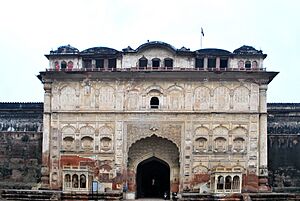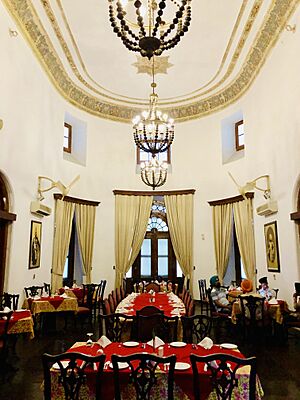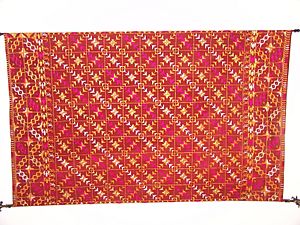Patiala facts for kids
Quick facts for kids
Patiala
|
|
|---|---|
|
City
|
|
|
Moti Bagh Palace
Art Deco design Phul Theatre
Gurdwara Dukh Nivaran Sahib
Shri Kali Devi Temple, Patiala
Qila Mubarak
Baradari Palace
|
|
| Country | |
| State | Punjab |
| District | Patiala |
| Before | Patiala State |
| Settled | 1754 |
| Founded by | Ala Singh |
| Named for | Ala Singh |
| Government | |
| • Type | Municipality |
| • Body | Municipal Corporation of Patiala |
| Area | |
| • City | 60 sq mi (160 km2) |
| • Metro | 141.57 sq mi (366.66 km2) |
| Elevation | 843 ft (257 m) |
| Population
(2021)
|
|
| • City | 763,280 |
| • Density | 12,400/sq mi (4,770/km2) |
| • Metro | 820,000 |
| Demonym(s) | Patialvi |
| Languages | |
| • Official | Punjabi |
| • Regional | Punjabi |
| Time zone | UTC+5:30 (IST) |
| PIN |
147001 to 147008 and 147021 to 147023
|
| Telephone code | Patiala: 91-(0)175 |
| ISO 3166 code | IN-Pb |
| Vehicle registration | PB-11 |
Patiala is a city in southeastern Punjab, India. It is the fourth largest city in the state. Patiala is also the main city of the Patiala district. The city is built around the Qila Mubarak (meaning 'Blessed Castle'). This castle was built by a leader named Ala Singh. He founded the royal family of Patiala State in 1763. The city is named after him.
Patiala is known for its traditional items. These include the Patiala shahi turban (a type of head covering). It is also famous for paranda (a decorative hair accessory). The Patiala salwar (a type of female trousers) and jutti (a type of footwear) are also well-known. People often call Patiala the Royal City or the Beautiful City.
Contents
What's in a Name? Patiala's Meaning
The name 'Patiala' comes from two words: pati and ala. Pati is a local word for "husband" or "land owner". Ala means "grand" and is also the name of the city's founder, Ala Singh. So, 'Patiala' means ‘the land of Ala Singh’.
Patiala's Royal Past
Patiala city was started in 1763 by Ala Singh. He was a Jat Sikh leader. He built the Qila Mubarak fort. The city of Patiala grew around this fort.
After a big battle in 1761, the Afghans took control of Punjab. This is when Patiala's rulers started to become powerful. For over 40 years, Patiala fought against the Afghans, the Marathas, and the Sikh Empire.
In 1808, the Raja of Patiala made a deal with the British. They teamed up against the Sikh ruler Maharaja Ranjit Singh. This helped the British expand their empire in India. Patiala became a very important state under British rule. Its rulers were treated with great respect.
The city of Patiala was planned like a temple. The first people to settle there were Punjabi Hindus from Sirhind. They opened their shops outside the Darshani Gate.
Where is Patiala?
Patiala is located at 30°19′N 76°24′E / 30.32°N 76.40°E. It is about 250 meters (820 feet) above sea level. For a short time, Patiala was the capital city of PEPSU.
Patiala's Weather
| Climate data for Patiala (1981–2010, extremes 1901–2010) | |||||||||||||
|---|---|---|---|---|---|---|---|---|---|---|---|---|---|
| Month | Jan | Feb | Mar | Apr | May | Jun | Jul | Aug | Sep | Oct | Nov | Dec | Year |
| Record high °C (°F) | 28.4 (83.1) |
33.3 (91.9) |
37.8 (100.0) |
44.6 (112.3) |
47.0 (116.6) |
46.4 (115.5) |
45.0 (113.0) |
42.7 (108.9) |
40.6 (105.1) |
38.9 (102.0) |
35.4 (95.7) |
29.4 (84.9) |
47.0 (116.6) |
| Mean daily maximum °C (°F) | 19.2 (66.6) |
22.0 (71.6) |
27.3 (81.1) |
34.8 (94.6) |
38.6 (101.5) |
38.6 (101.5) |
34.2 (93.6) |
33.0 (91.4) |
32.9 (91.2) |
31.7 (89.1) |
27.3 (81.1) |
21.8 (71.2) |
30.1 (86.2) |
| Mean daily minimum °C (°F) | 6.6 (43.9) |
9.0 (48.2) |
13.6 (56.5) |
18.6 (65.5) |
23.4 (74.1) |
26.2 (79.2) |
26.5 (79.7) |
25.9 (78.6) |
23.6 (74.5) |
17.3 (63.1) |
11.2 (52.2) |
7.4 (45.3) |
17.4 (63.3) |
| Record low °C (°F) | −0.9 (30.4) |
0.1 (32.2) |
3.5 (38.3) |
9.9 (49.8) |
15.0 (59.0) |
18.2 (64.8) |
20.4 (68.7) |
20.1 (68.2) |
15.0 (59.0) |
10.0 (50.0) |
3.7 (38.7) |
0.4 (32.7) |
−0.9 (30.4) |
| Average rainfall mm (inches) | 28.2 (1.11) |
24.5 (0.96) |
15.6 (0.61) |
10.6 (0.42) |
21.6 (0.85) |
73.1 (2.88) |
216.9 (8.54) |
224.1 (8.82) |
120.7 (4.75) |
10.3 (0.41) |
2.2 (0.09) |
10.3 (0.41) |
758.1 (29.85) |
| Average rainy days | 2.0 | 1.7 | 1.0 | 1.2 | 1.6 | 3.3 | 7.2 | 7.3 | 3.4 | 0.5 | 0.3 | 0.6 | 30.2 |
| Average relative humidity (%) (at 17:30 IST) | 68 | 61 | 53 | 33 | 31 | 43 | 69 | 76 | 70 | 58 | 59 | 66 | 57 |
| Source: India Meteorological Department | |||||||||||||
Patiala was ranked 27th as a "National Clean Air City" in India. This was for cities with 3-10 lakh (300,000-1,000,000) people.
People of Patiala
In 2021, Patiala city had a population of 763,280 people. About 54% of the people were male and 46% were female. Most people in Patiala can read and write. The literacy rate was 86%, which is higher than the national average. About 10% of the population was under 5 years old.
Religions in Patiala
| Religion in Patiala City (2011) | ||||
|---|---|---|---|---|
| Religion | Percent | |||
| Hinduism | 57.22% | |||
| Sikhism | 39.96% | |||
| Islam | 1.87% | |||
| Christianity | 0.41% | |||
| Others | 0.54% | |||
Hinduism is the largest religion in Patiala. There is also a large number of Sikh people.
Fun Places to Visit in Patiala
Kali Devi Mandir
Kali Devi Temple is a Hindu temple for Maa Kaali. Maharaja Bhupinder Singh, a Sikh ruler, built this temple. He paid for it and helped set it up in 1936. People say he built it to protect the city from floods.
Maharaja Bhupinder Singh ruled Patiala from 1900 to 1938. He brought a 6-foot statue of Divine Mother Kali from Bengal. He also brought a special flame. This temple is now a national monument because of its beautiful design. Many people, both Hindu and Sikh, visit this large temple.
An older temple, Raj Rajeshwari, is also inside this complex. The temple is across from the Baradari garden on Mall Road. People offer many things to the Divine Mother. These include mustard oil, lentils, sweets, coconuts, and bangles.
Gurdwara Dukh Niwaran Sahib
Local stories say that a man named Bhag Ram asked Guru Tegh Bahadur for help. His village, Lehal, had a strange sickness. The Guru visited Lehal on January 24, 1672. He sat under a banyan tree by a pond. The sickness in the village then went away.
The place where the Guru sat became known as Dukh Nivaran. This means "eradicator of suffering." People believe the water in the sacred pool here has healing powers. They think that bathing in the pool for five days in a row can cure illnesses. This Gurdwara is near the Patiala Bus Station.
Gurdwara Moti Bagh
Gurudwara Moti Baag is on the edge of Patiala City. Guru Teg Bahadur visited this place on his way to Delhi. He stayed here for three months. A follower named Saif Ali Khan served the Guru with great care. During the day, Guru Teg Bahadur meditated inside the fort. At night, he would come here.
Bahadurgarh Fort
The Bahadurgarh Fort is 6 kilometers (about 3.7 miles) from Patiala city. It is on the road to Chandigarh. A Mughal Nawab named Saif Khan built the fort in 1658 A.D. Guru Teg Bahadur visited him there. Later, a Sikh ruler, Maharaja Karam Singh, rebuilt it in 1837. The fort took eight years to build and cost a lot of money. It covers an area of 2 square kilometers (about 0.77 square miles).
The fort has two round walls and a moat (a deep ditch). Its total length is a bit over two kilometers. Maharaja Karam Singh named it Bahadurgarh Fort. This was to honor Guru Teg Bahadur, who stayed there for over three months. The fort has a historical Gurdwara Sahib (a Sikh temple). This Gurudwara shows beautiful Sikh architecture. Many people visit it during the Baisakhi festival on April 13 each year.
Qila Mubarak Complex
The Qila Mubarak complex is in the middle of Patiala. It covers 10 acres of land. It includes the main palace, Qila Androon (meaning 'inner fort'). There is also a guesthouse called Ran Baas and the Darbar Hall. Outside the fort, you can find the Darshani Gate and a Shiva temple. There are also shops selling jewelry, fabrics, and footwear.
This complex was where the Patiala royal family lived. They moved to the Old Moti Bagh Palace later. The palace entrance is a grand gate. Its style mixes Mughal and Rajasthani architecture. The complex has ten courtyards. Each courtyard is different in size and design. Some are wide, others are small.
The Androon is one large building, but people talk about it as many palaces. Each group of rooms is around a courtyard. They have names like Topkhana, Qila Mubarak, Sheesh Mahal, Treasury, and Prison. Ten rooms have beautiful paintings or are decorated with mirrors and gold.
A small part of the complex has British-style buildings. These have Gothic arches and marble fireplaces. Burj Baba Ala Singh has a fire that has been burning since Ala Singh's time. It was lit with a flame from Jwalaji. Every year, it is decorated for the Heritage Festival.
Sheesh Mahal
The Sheesh Mahal, or Palace of Mirrors, is part of the Old Moti Bagh Palace. Maharajas built it in the 19th century. It has many frescoes (wall paintings). Most of these were made when Maharaja Narinder Singh was ruler. A lake in front of the palace makes it even more beautiful.
The Lakshman Jhula is a bridge over this lake. It is a popular spot. The Mahal also has a museum. It holds the world's largest collection of medals. These were collected by Maharaja Bhupinder Singh.
Right now, the museum and main building are closed for repairs. But visitors can still enjoy the palace surroundings and the Lakshman Jhula.
Baradari Gardens
The Baradari Gardens are north of old Patiala city. They are just outside Sheranwala Gate. Maharaja Rajindera Singh created these gardens. They have many rare trees, shrubs, and flowers. There are also impressive old buildings and a marble statue of Maharaja Rajindera Singh.
The gardens were built as a royal home. They included a cricket stadium and a skating rink. A small palace called Rajindera Kothi is in the center. The gardens also have a museum with collections from Maharaja Ranjeet Singh.
After being restored, the gardens opened as a heritage hotel in 2009. It is Punjab's first heritage hotel. It is run by the Neemrana Hotels group. The Press Club Patiala is also located near the Baradari Garden.
Patiala's 12 Royal Gates
Patiala has 12 historic gates:
- Darshani Gate - The main entrance to Qila Mubarak
- Sanouri Gate
- Lahori Gate
- Sherawala Gate
- Sunami Gate
- Sirhindi Gate
- Ghalori Gate
- Safabadi Gate
- Top Khana Gate
- Nabha Gate
- Samania Gate
- Rajindera Gate
National Institute of Sports
The Netaji Subhas National Institute of Sports (NIS) started in 1961. It is Asia's largest sports institute. It is located in Patiala. The institute was renamed in January 1973.
NIS is in the Old Moti Bagh palace. This palace used to belong to the royal family of Patiala. The Indian government bought it after India became independent. Today, the NIS Museum has many sports items. These include a 95 kg (209 lb) exercise disc used by the Great Gama. It also has Major Dhyan Chand's gold medal from the 1928 Amsterdam Olympics. You can also see PT Usha's shoes from the 1986 Seoul Asiad.
Patiala Central State Library
The Patiala Central State Library is one of the oldest libraries in Punjab. It opened in 1956. It is named after Giani Gurmukh Singh Musafir, a former Chief Minister of Punjab. The library has a special collection of books. There are over 135,000 books in total. More than 15,000 of these are old, rare books. There are also 3,000 rare handwritten documents.
Patiala's Culture and Traditions
Patiala was important for more than just politics. It was also a center for religion and culture. Patiala was a leader in education. It was the first city in this region to have a degree college, the Mohindra College, in 1870.
Patiala has its own unique style of architecture. It combines the Rajput style with local traditions. This creates a beautiful and elegant look.

The Maharajas of Patiala strongly supported music. This led to a special style of Hindustani music called the "Patiala gharana". This music style is still famous today. Many great musicians came to Patiala after the Mughal Court in Delhi broke up in the 18th century. Ustad Ali Bux was a very famous musician of this style. Later, his sons, Ustad Akhtar Hussain Khan and Ustad Bade Ghulam Ali Khan, became world-famous. They brought great honor to the Patiala Gharana.
After India was divided in 1947, many people moved. The Maharaja of Patiala, Yadavindra Singh, and his wife, Maharani Mohinder Kaur, helped a lot. They set up many camps and worked hard for the people.
Getting Around Patiala
Patiala is connected to other cities by road. You can reach cities like Ambala, Chandigarh, Amritsar, and Delhi. It is also well connected to Ludhiana and Jalandhar. National Highway 64 links Patiala to Rajpura and Zirakpur.
Patiala has a railway station. It also has a Patiala Airport, but it is not currently used. The closest airport for flights is Chandigarh Airport. It is about 62 kilometers (38.5 miles) away. Patiala is also very close to Nabha city, about 27 kilometers (16.8 miles) away.
Learning in Patiala
Since India became independent in 1947, Patiala has become a big education center in Punjab. The city has many important colleges and universities. These include the Thapar Institute of Engineering and Technology and Punjabi University. It also has the Rajiv Gandhi National University of Law.
The Netaji Subhas National Institute of Sports in Patiala is a major sports training center. The Rajiv Gandhi National University of Law was the first national law school in northern India. It was started by the Punjab Government in 2006.
Here are some universities in Patiala:
| Name | Type of university |
|---|---|
| Punjabi University | State University |
| Thapar University | Deemed University |
| Rajiv Gandhi National University of Law | National University |
| Punjab Sports University | State University |
| Jagat Guru Nanak Dev Punjab State Open University | State University |
| Chitkara University | Private University |
Some notable schools in Patiala are:
- The British Co-Ed High School
- Our Lady of Fatima Convent Sec. School, Patiala
- Guru Nanak Foundation Public School, Patiala
- Meritorious School Patiala
- Scholar Fields Public School, Patiala
- St. Peter's Academy, Patiala
- Yadavindra Public School, Patiala (YPS Patiala)
Sports in Patiala
Patiala has many sports teams. The city has places for cricket, swimming, shooting, skating, and hockey. There are stadiums like Dhruv Pandove Ground and Yadavindra Sports Stadium. The National Institute of Sports is also here.
A new shotgun shooting range has been built at the New Moti Bagh Gun Club. The royal family of Patiala started these ranges. The Indian Shotgun Shooting team often trains here. It recently hosted the 2nd Asian Shotgun Championship.
Famous People from Patiala
Nearby Towns to Patiala
- Nabha (Municipal Council) 25 km (15.5 miles) away
- Rajpura (Municipal Council) 27 km (16.8 miles) away
- Samana (Municipal Council) 27 km (16.8 miles) away
See also
 In Spanish: Patiala para niños
In Spanish: Patiala para niños





















